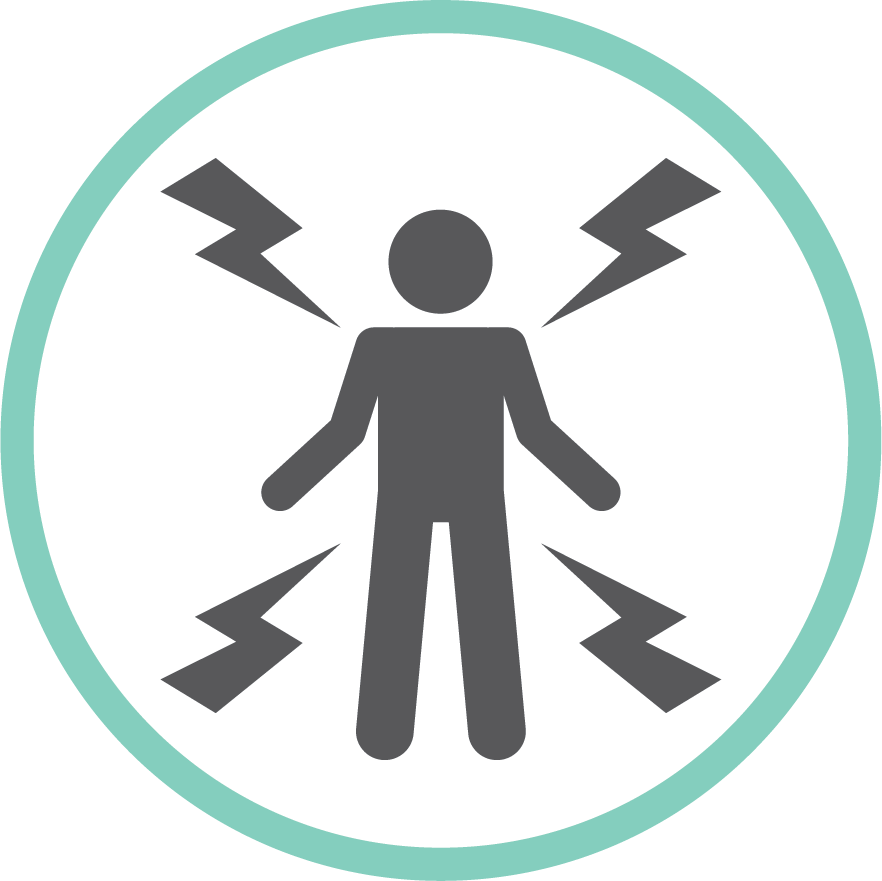
Epidural steroid injection – the procedure involves alleviating neck or back pain, which radiates to the arms or legs along the path of the nerve pathways by injecting medication into the epidural space.

Facet joint injection / Medial branch block – the procedure involves alleviating pain from facet joint in the neck or back, which is not radiating to the arms or legs along the nerve pathways, by injecting medication into the facet joint or the nerves that innervate the facet joint.

Peripheral nerve block - the procedure involves alleviating pain from nerves by injecting medication into the peripheral nerve endings.

Radiofrequency ablation (RFA) - the procedure involves alleviating chronic pain by using radiofrequency waves transmitted through needles to convert into heat energy directed towards various nerves. It aims to provide long-lasting pain relief, for example, in cases of back pain where medial branch block injections have effectively reduced pain from facet joints. The goal is to extend the pain relief for a period of 3 to 12 months.

Sympathetic block - the procedure involves alleviating pain arising from the sympathetic nervous system, particularly in complex regional pain syndrome, where there is chronic pain in the extremities that may develop following an injury. It involves injecting medication into the sympathetic nervous system to target the area where the pain is localized.

Celiac plexus neurolysis - the procedure involves alleviating severe pain resulting from upper abdominal cancers, such as pancreatic cancer, by injecting medication into the group of nerves known as the celiac plexus.

Intrathecal drug delivery device implantation - the procedure involves alleviating pain in patients who are taking high doses of opioid, which may lead to side effects. It involves delivering medication through the spinal canal, allowing for a reduction in the amount of opioids used and minimizing the associated side effects.

Spinal cord stimulation - the procedure involves alleviating difficult-to-treat chronic pain conditions such as pain in the arms or legs due to poor blood flow, refractory nerve pain, or complex regional pain syndrome. It involves implanting a device that generates a gentle electrical current passed through electrodes implanted in the upper layers of the spinal cord to provide pain relief.
 Post-surgical pain such as phantom limb pain or post major operative pain
Post-surgical pain such as phantom limb pain or post major operative pain
 Muscle pain
Muscle pain Nerve pain such as pain from shingles infection, pain from diabetes etc.
Nerve pain such as pain from shingles infection, pain from diabetes etc.
 Cancer pain
Cancer pain Chronic neck pain
Chronic neck pain Chronic back pain
Chronic back pain Chronic shoulder pain
Chronic shoulder pain Chronic knee pain
Chronic knee pain Chronic pain from other causes
Chronic pain from other causes Trigger point injection - the procedure involves alleviating muscle tightness and stiffness caused by myofascial pain syndrome using acupuncture and medication.
Trigger point injection - the procedure involves alleviating muscle tightness and stiffness caused by myofascial pain syndrome using acupuncture and medication. Epidural steroid injection – the procedure involves alleviating neck or back pain, which radiates to the arms or legs along the path of the nerve pathways by injecting medication into the epidural space.
Epidural steroid injection – the procedure involves alleviating neck or back pain, which radiates to the arms or legs along the path of the nerve pathways by injecting medication into the epidural space. Facet joint injection / Medial branch block – the procedure involves alleviating pain from facet joint in the neck or back, which is not radiating to the arms or legs along the nerve pathways, by injecting medication into the facet joint or the nerves that innervate the facet joint.
Facet joint injection / Medial branch block – the procedure involves alleviating pain from facet joint in the neck or back, which is not radiating to the arms or legs along the nerve pathways, by injecting medication into the facet joint or the nerves that innervate the facet joint. Peripheral nerve block - the procedure involves alleviating pain from nerves by injecting medication into the peripheral nerve endings.
Peripheral nerve block - the procedure involves alleviating pain from nerves by injecting medication into the peripheral nerve endings. Radiofrequency ablation (RFA) - the procedure involves alleviating chronic pain by using radiofrequency waves transmitted through needles to convert into heat energy directed towards various nerves. It aims to provide long-lasting pain relief, for example, in cases of back pain where medial branch block injections have effectively reduced pain from facet joints. The goal is to extend the pain relief for a period of 3 to 12 months.
Radiofrequency ablation (RFA) - the procedure involves alleviating chronic pain by using radiofrequency waves transmitted through needles to convert into heat energy directed towards various nerves. It aims to provide long-lasting pain relief, for example, in cases of back pain where medial branch block injections have effectively reduced pain from facet joints. The goal is to extend the pain relief for a period of 3 to 12 months. Sympathetic block - the procedure involves alleviating pain arising from the sympathetic nervous system, particularly in complex regional pain syndrome, where there is chronic pain in the extremities that may develop following an injury. It involves injecting medication into the sympathetic nervous system to target the area where the pain is localized.
Sympathetic block - the procedure involves alleviating pain arising from the sympathetic nervous system, particularly in complex regional pain syndrome, where there is chronic pain in the extremities that may develop following an injury. It involves injecting medication into the sympathetic nervous system to target the area where the pain is localized. Celiac plexus neurolysis - the procedure involves alleviating severe pain resulting from upper abdominal cancers, such as pancreatic cancer, by injecting medication into the group of nerves known as the celiac plexus.
Celiac plexus neurolysis - the procedure involves alleviating severe pain resulting from upper abdominal cancers, such as pancreatic cancer, by injecting medication into the group of nerves known as the celiac plexus. Intrathecal drug delivery device implantation - the procedure involves alleviating pain in patients who are taking high doses of opioid, which may lead to side effects. It involves delivering medication through the spinal canal, allowing for a reduction in the amount of opioids used and minimizing the associated side effects.
Intrathecal drug delivery device implantation - the procedure involves alleviating pain in patients who are taking high doses of opioid, which may lead to side effects. It involves delivering medication through the spinal canal, allowing for a reduction in the amount of opioids used and minimizing the associated side effects. Spinal cord stimulation - the procedure involves alleviating difficult-to-treat chronic pain conditions such as pain in the arms or legs due to poor blood flow, refractory nerve pain, or complex regional pain syndrome. It involves implanting a device that generates a gentle electrical current passed through electrodes implanted in the upper layers of the spinal cord to provide pain relief.
Spinal cord stimulation - the procedure involves alleviating difficult-to-treat chronic pain conditions such as pain in the arms or legs due to poor blood flow, refractory nerve pain, or complex regional pain syndrome. It involves implanting a device that generates a gentle electrical current passed through electrodes implanted in the upper layers of the spinal cord to provide pain relief.




